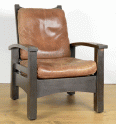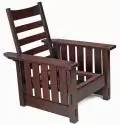The Morris Chair: An American Arts & Crafts Classic

While William Morris may have been given too much credit for its invention (and the version he marketed at Morris & Co. looks suspiciously Victorian today), the adjustable back armchair bearing his name has emerged as the classic example of Arts & Crafts design and craftsmanship.
In America, every major Arts & Crafts furniture company had their version of a Morris chair, making it one of the most available forms in the Arts & Crafts marketplace today. Each company developed their own individual design elements that provide collectors with ample topics for discussion.
The Roycrofters, for instance, were noted for their sprawling ‘paddlearm’ version, which, while not perfectly proportioned, is considered very rare by collectors.
The designers working for Charles Limbert offered everything from lightweight, scaled-down versions to a series of massive recliners with square and trapezoidal cutouts influenced by the European designers Josef Hoffmann and Charles Rennie Mackintosh. The lightweight versions don’t cause much excitement, but when one of Limbert’s cutout recliners is in the room, it generates electricity.
Albert Stickley of Stickley Brothers fame in Grand Rapids, apparently left the Morris chair market to his brothers Leopold and Gustav, preferring, instead, to concentrate on rockers and armchairs. His Morris chairs, when found, are rather uninspiring.
The designers hired by Gustav Stickley in Syracuse and Leopold Stickley in nearby Fayetteville seem to have waged a friendly competition to see who could produce the most popular Morris chair. First came the flat-arm, then the bow-arm (see top photo), then the bent-arm versions. Early forms had wide slats under the arms, but for a few years Gustav experimented with small, square spindles, which proved prone to warping. Gustav liked shorter corbels under the arms; Leopold preferred a longer, graceful corbel. Gustav employed pegs to support the adjustable back; Leopold often opted for a wooden bar.
In addition to these well-recognized names, other firms, including J. M. Young, Harden and the Quaint Art Furniture Company, produced Morris chairs that today are prized by collectors.
When shopping for a Morris chair, collectors are advised to consider the following:
1.) Heavier is better. Lightweight forms are not as popular as the heavyweights.
2.) The more slats under the arms, the better.
3.) Four corbels are better than two; two are better than none.
4.) Quartersawn oak flake is preferred over less dramatic plain sawn lumber.
5.) Exposed tenons on the tops of the arms and the sides of the legs are a desirable design feature.
6.) So are pegged joints.
7.) Check for damage or repairs at the stress points where the back is either hinged or pivots on pegs.
8.) An original finish is always more desirable than a new finish.
9.) Original upholstery is so rare (and fragile) that it is not a demerit to have modern upholstery, provided it is an Arts & Crafts fabric or leather.
10.) Buy for design and condition, not the name on the shopmark. A flimsy, lightweight 1915 Gustav Stickley recliner is still a flimsy, lightweight 1915 recliner.
Happy Shopping!
-bj

